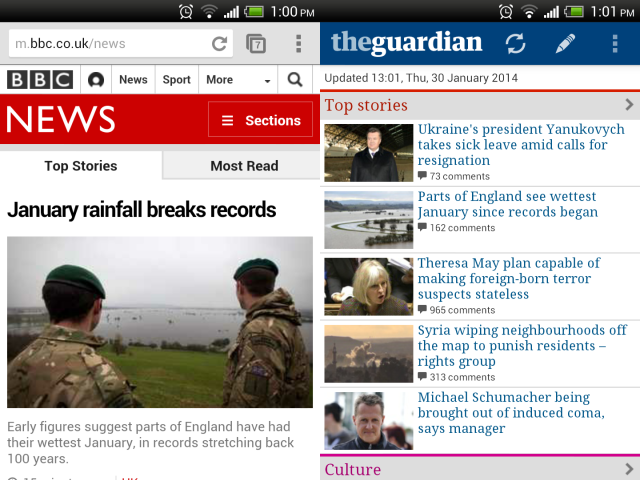Earlier this year I presented a lecture about ‘Writing for online’ at the University of Lincoln. This is the next step on from ‘Tips for blogging and tweeting’ and looks more specifically at how websites for newspapers and magazines work.
Design is important to consider for newspaper and magazine layout, and the same applies to their websites. It’s a useful tool to attract readers, demonstrate that you are a trustworthy source of information and get people picking up your publication or visiting your title again.
Homepages
Print publications have a front page whereas online you have a homepage. They both act as a welcome page to your publication and should encourage people to read on as well as demonstrating the main points of your brand. All that means is when people look at it they should understand who you are writing for and what you are writing about.
Online homepages used to be the first page people would visit, but more readers are now coming in through the side door. This means more people are discovering articles through Google searches or social media. As a result every page now has to act as a homepage to attract readers and keep them interested.
Homepages are also important for advertising as it gives them something polished to show what your title is about, even if the rest of the website isn’t as organised. One good example of this is The Huffington Post. They use a tactic called ‘the mullet strategy‘ which means they are an established name because they cover serious stories but most people visit them for their lighter, viral stories. It’s called ‘the mullet strategy’ because they are “business upfront, party in the back”.
What makes a good website?
A good website needs to be easy to read and use. This means you need to figure out what you want to showcase to readers and what you think is important for them to see. Then consider the best way to show that to them. Also consider ways to share content as that can help get your articles and website read by more people.
It also helps to understand the technical side of running a website. If your website is appearing broken then you will know how to fix it rather than wait for someone else to fix it and lose visitors. It also means you can be prepared, as your intention is to get more people looking at your website then you will know how you to cope when there is a large amount of traffic visiting your site.
A site for sore eyes
It is hard to keep people’s attention online as there is so much to compete with. There will be some people who will read articles properly from beginning to end and others who will just scan read pieces. So think of ways to make your site appeal to a variety of people with some simple design and journalism skills.
 The easiest way is to make sure your content is interesting is to write good articles. Write well, get good interviews and make sure you tell it in the best way.
The easiest way is to make sure your content is interesting is to write good articles. Write well, get good interviews and make sure you tell it in the best way.
There are a few other tips as well including using sub headings breaks up long articles into simple chunks. It will also allow people to scan your article and find the bit that they want to read. Think about using pictures, video, audio and depending on your audience maybe gifs or structure the story as a list.
However, don’t feel pressured to use them all at once think which skills help to tell your story best and concentrate on them. Just because people have clicked on your story doesn’t mean they will watch a video too, unless you give them a reason.
There’s also plenty of room for experimentation online. Snowfall by the New York Times was one of the first interactive features which told the story of a US avalanche with lots of different visuals, videos and text and all the reader had to do was scroll down the website. The piece won a a Pullitzer prize but some see the New York Times’ work as a bit over the top so it depends what you are wanting to tell people.
There’s also the option to be quite simple online, as demonstrated by Trinity Mirror’s UsVsTh3m. It’s an interesting site and idea anyway but they wanted to focus on visual rather than articles. So when the Mars Rover accidentally drew a penis shape on the planet UsVsTh3m could just post a picture when other news sources were writing 200 words about the event and padding it out with irrelevant details.
Mobile websites
A mobile website is a scaled down version of the normal website that works best on a smartphone. These type of sites are very important as a number of readers are getting their news first. In fact in the UK one in five read the news only on their mobile according to a survey from September 2013.
Some sites could have a mobile app as well, but they need to be different from the mobile site. Generally people would already be loyal readers of the website and decide to download the app as well. They include features you don’t get on the mobile website for example the BBC News app sends out alerts for breaking news and the Guardian app allows you to customise which categories you would prefer to read.
SEO
SEO stands for Search Engine Optimisation and it helps more people to find your website. There are a lot of SEO techniques that are a lot of hard work and not particularly worth it. However, there are a few tips that you should pay attention to when writing online and will get you noticed:
- Tagging
- Strong headlines
- Useful links
- Good stories
- Regularly update your site
News is different nowadays
You need to be able to write your story in a variety of ways. There’s the article but also consider tweets and Facebook updates. When it comes to social media you need to be able to tell your whole story in about a sentence. And how would you approach a video or just an audio interview? If you are going to do them think about how you would do them well.
There’s also more sources of information to compete with — social media accounts and communities, blogs, hyperlocal websites, radio stations and TV channels. They will all have a different approach but they will have a competing online profile.
This is a summary of the full lecture, if you would like to find out more all the slides are below.


Leave a Reply